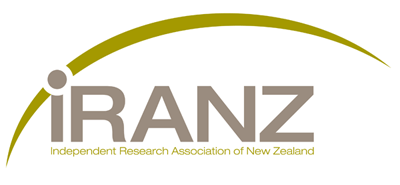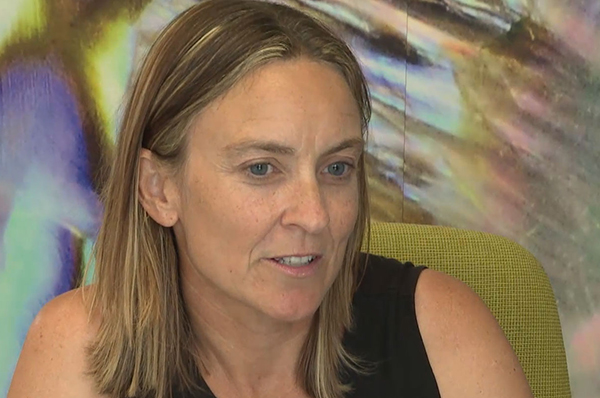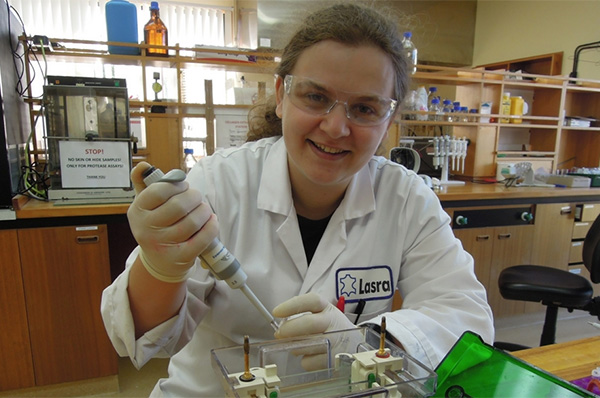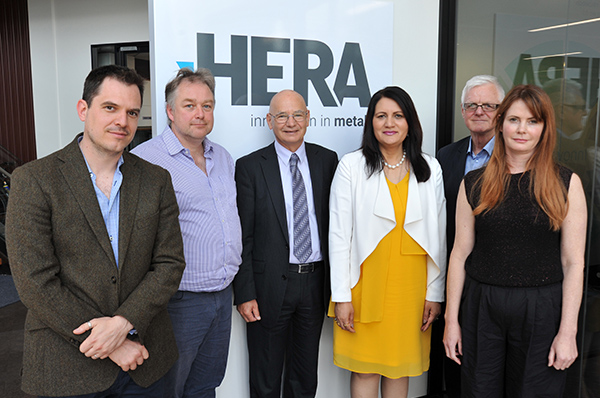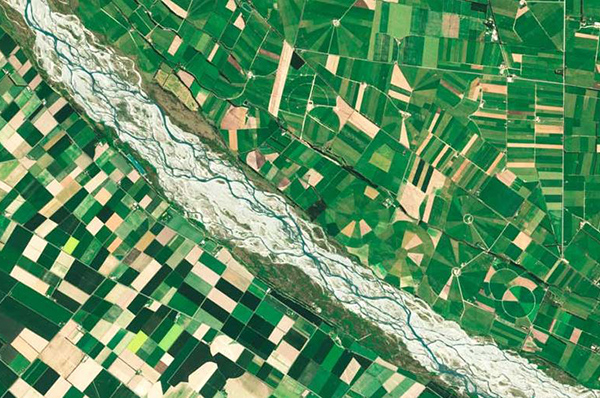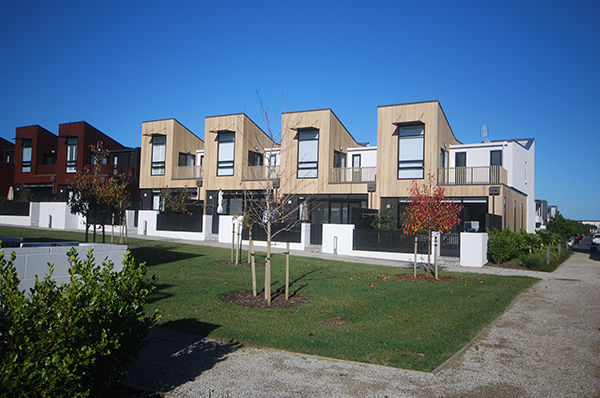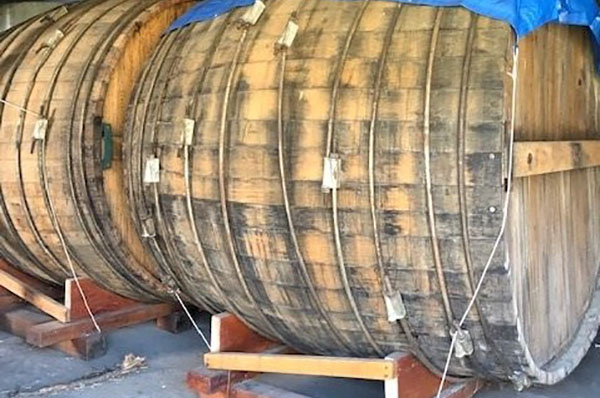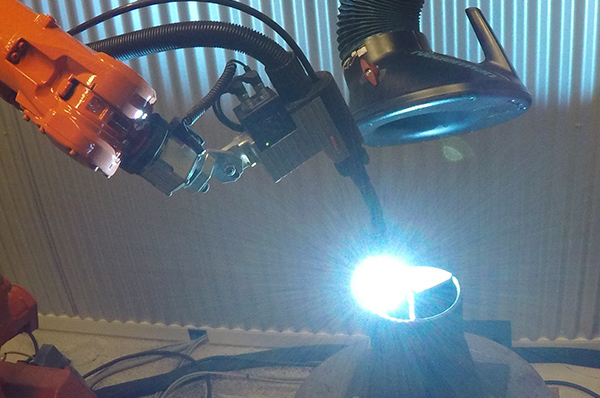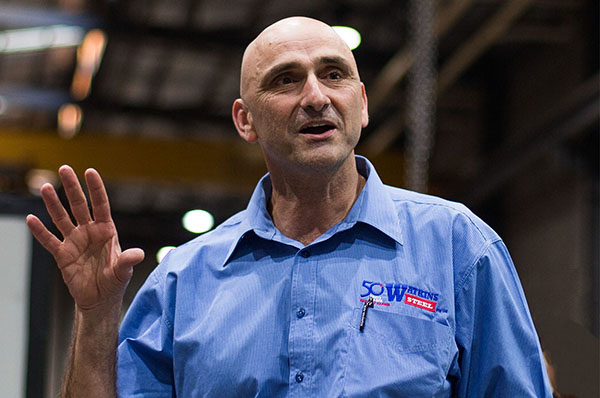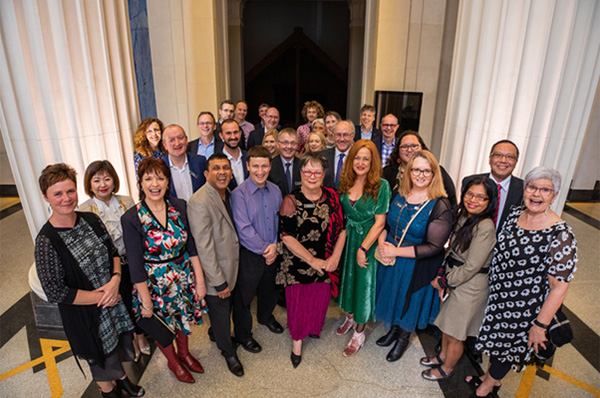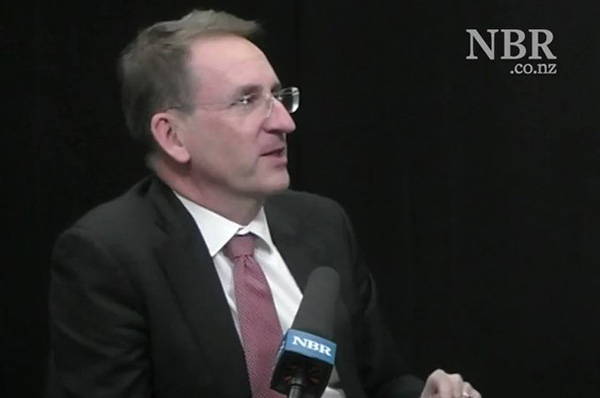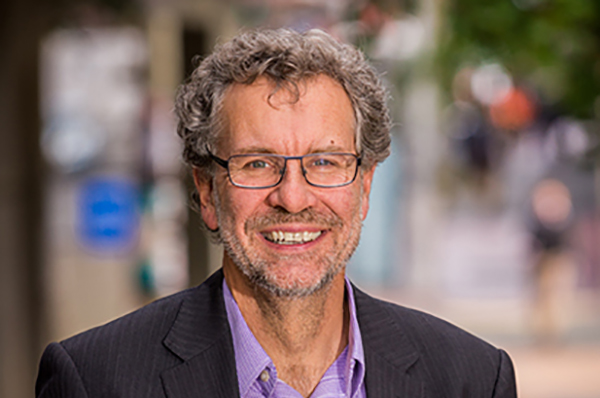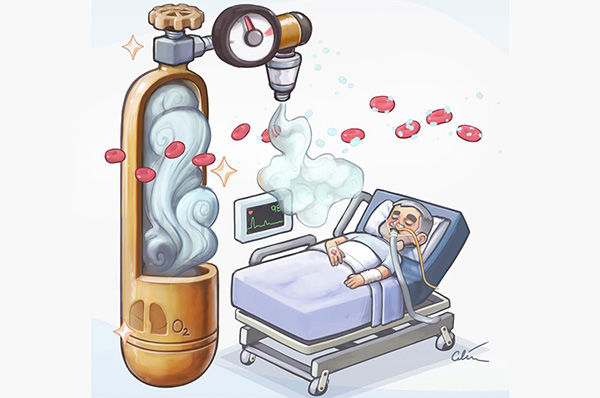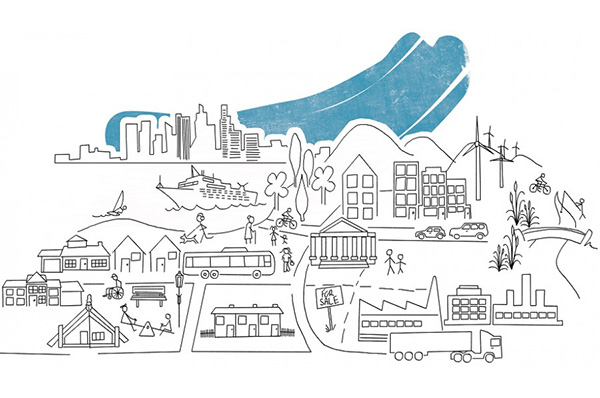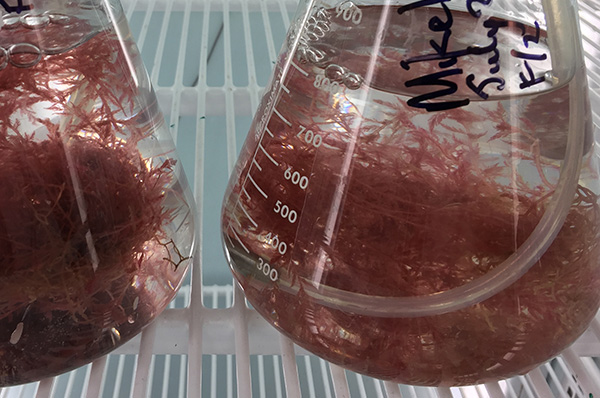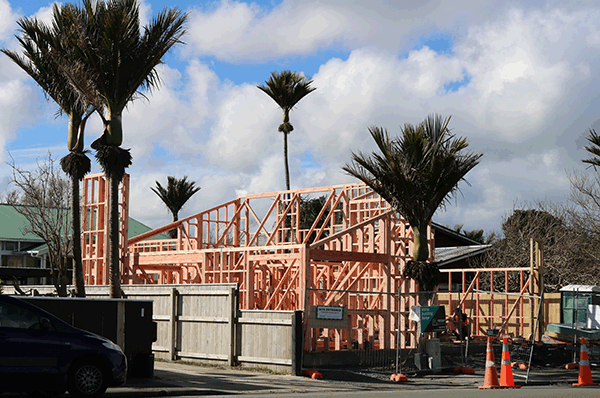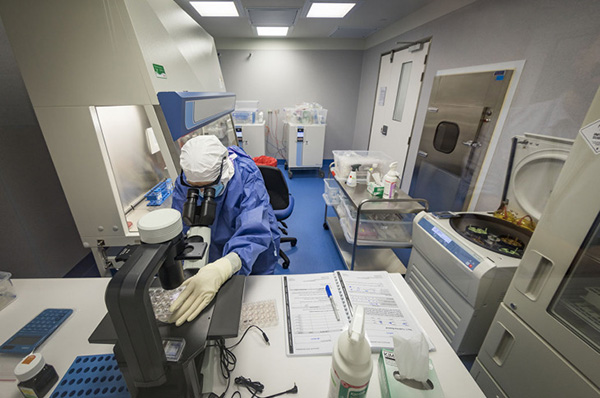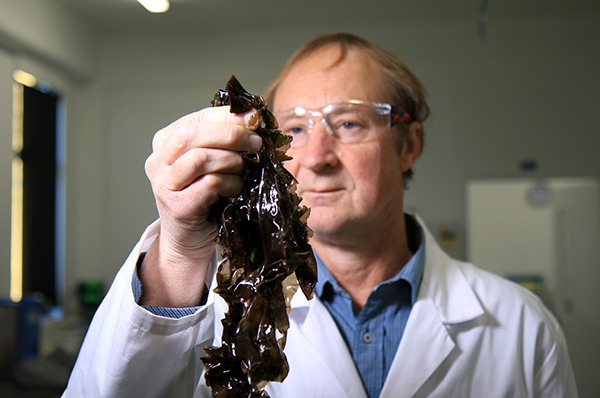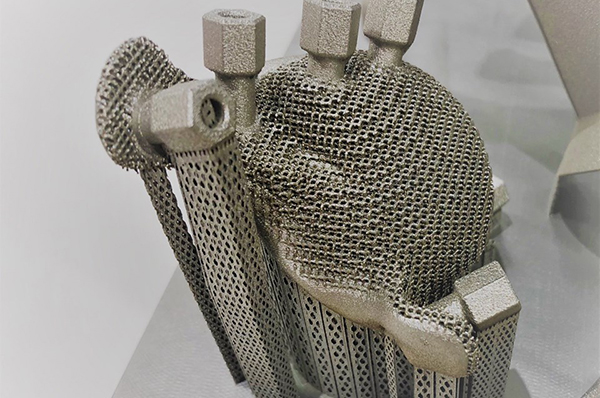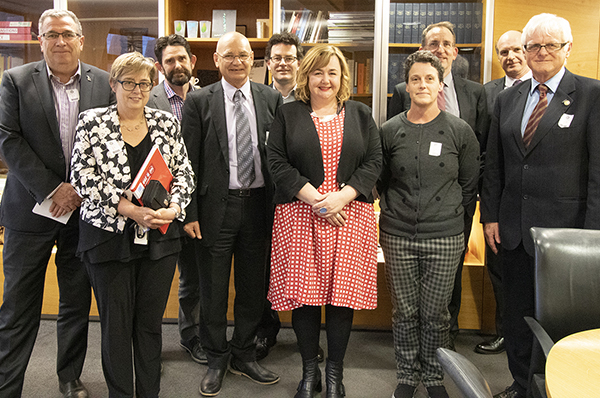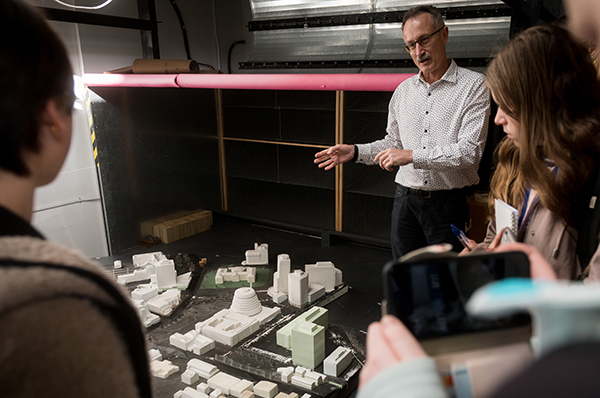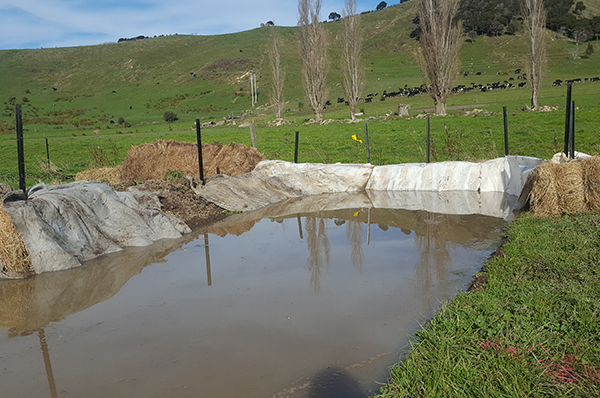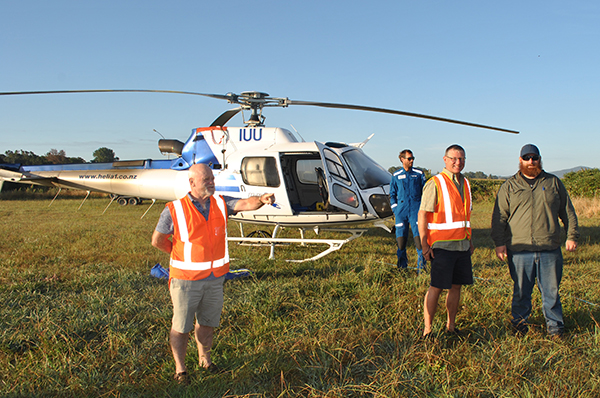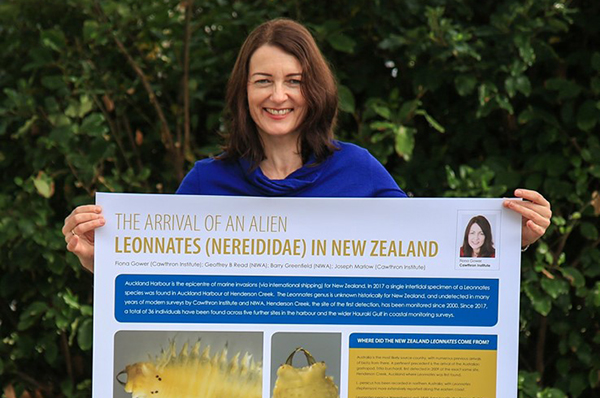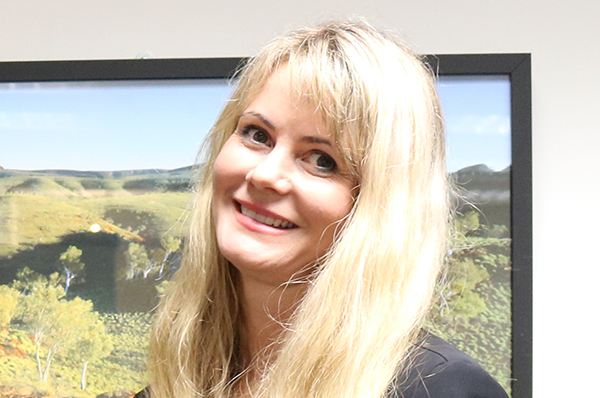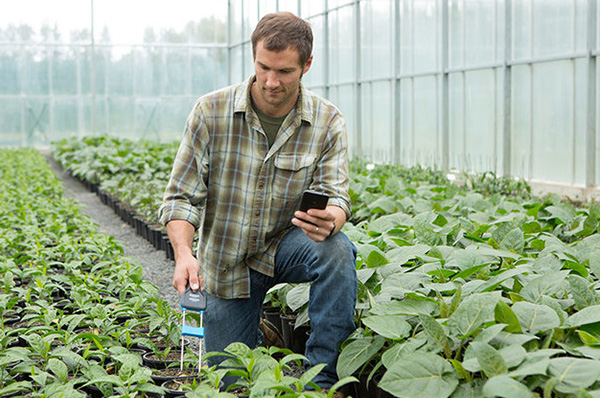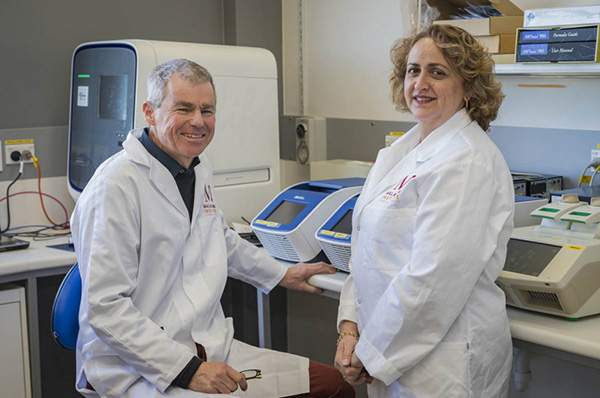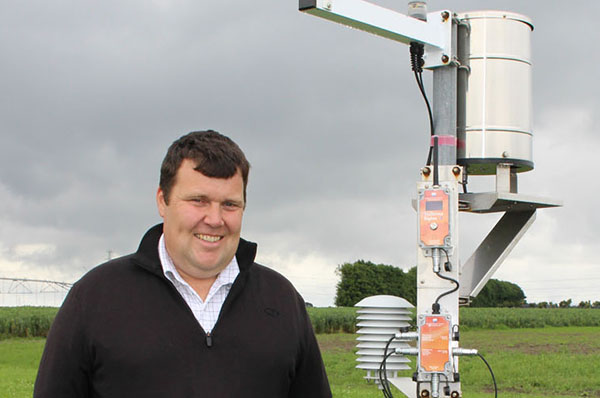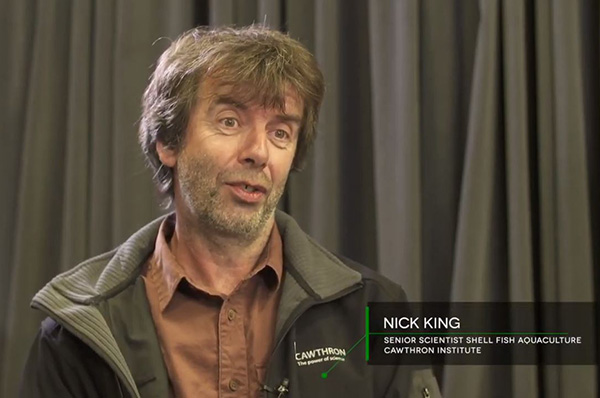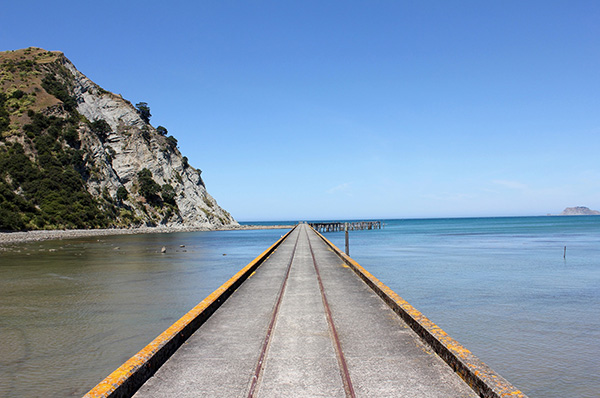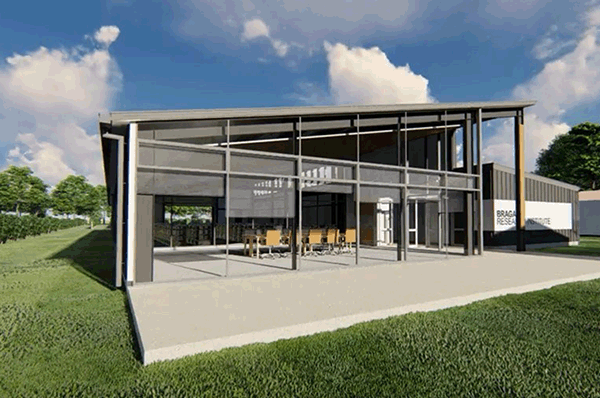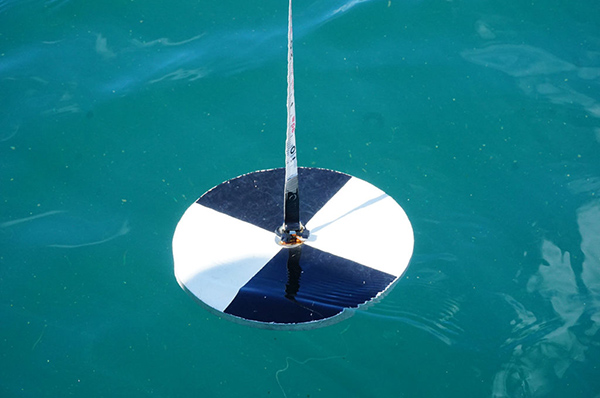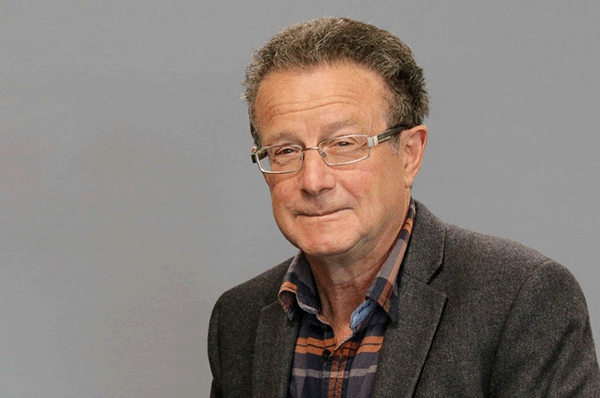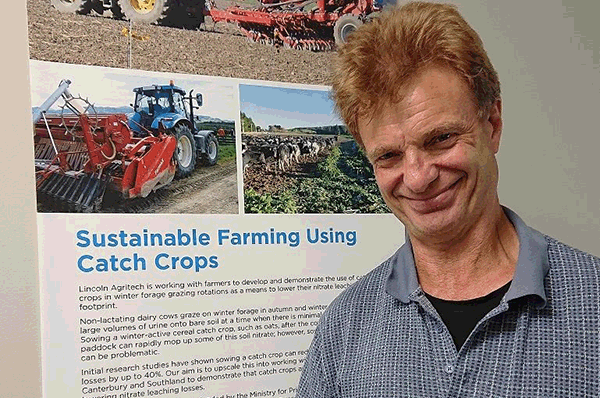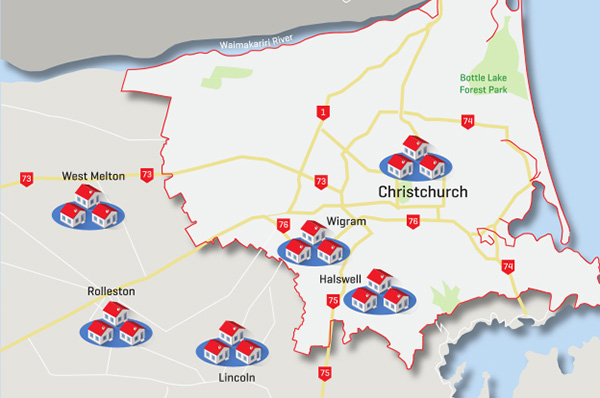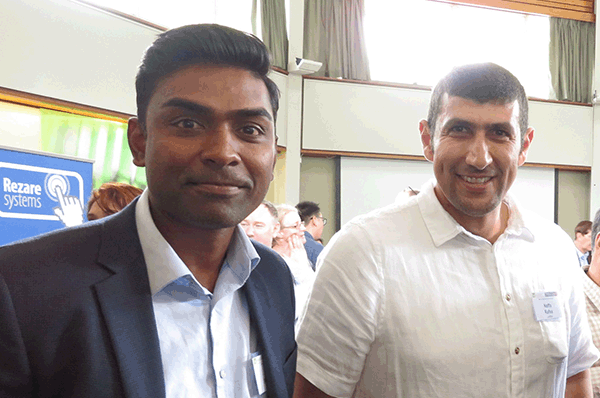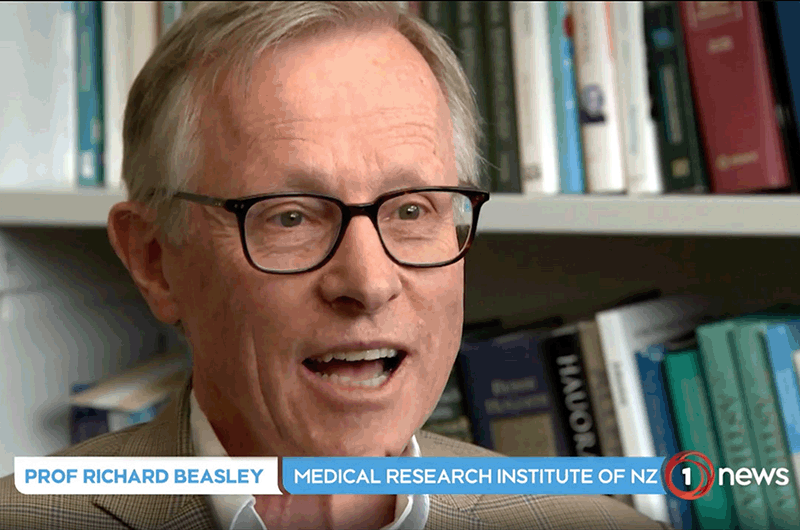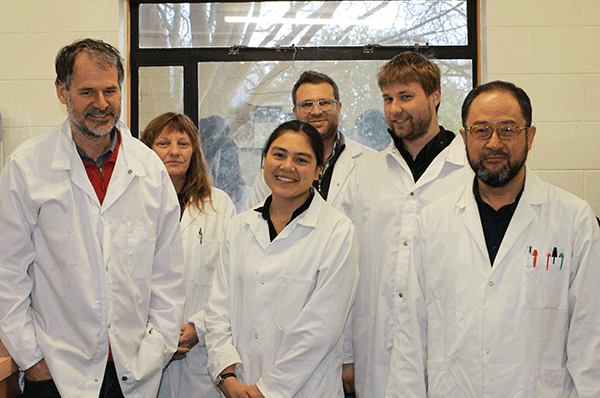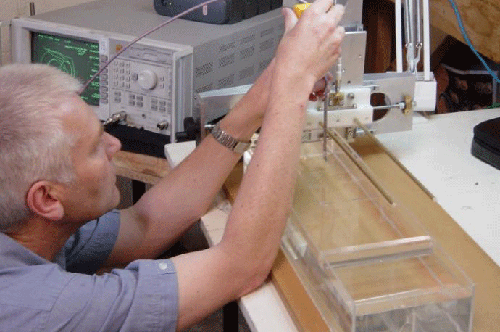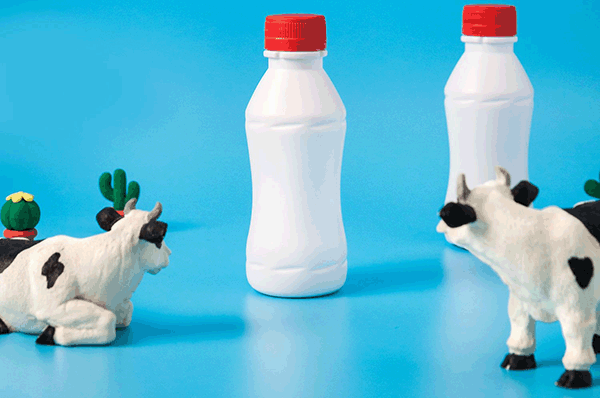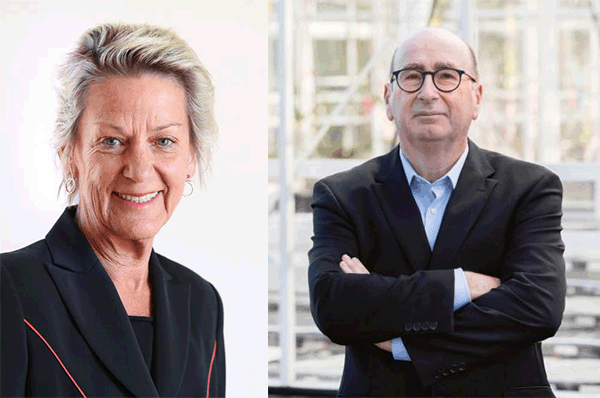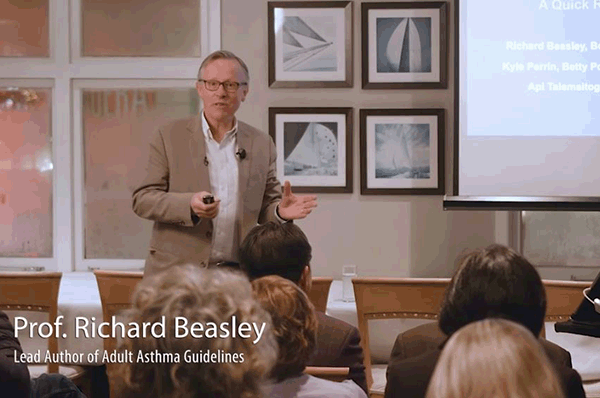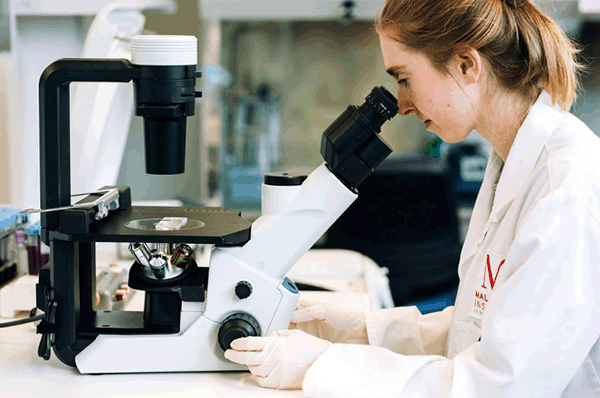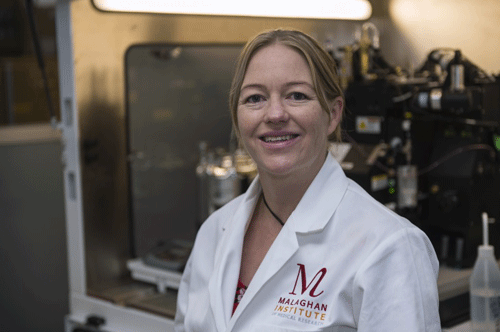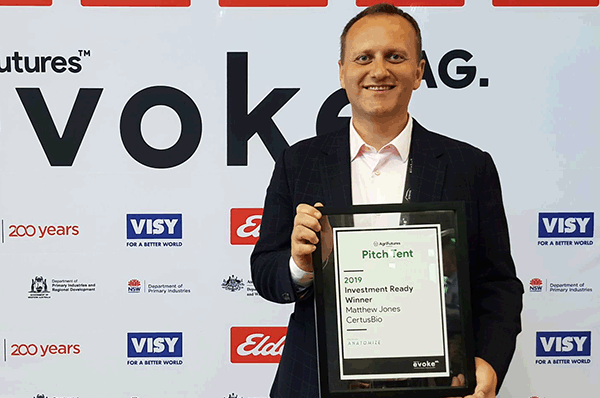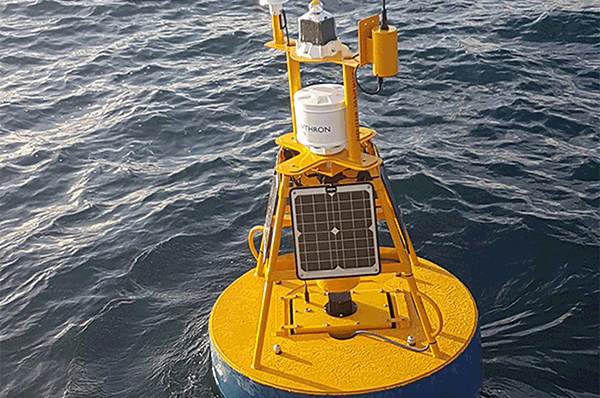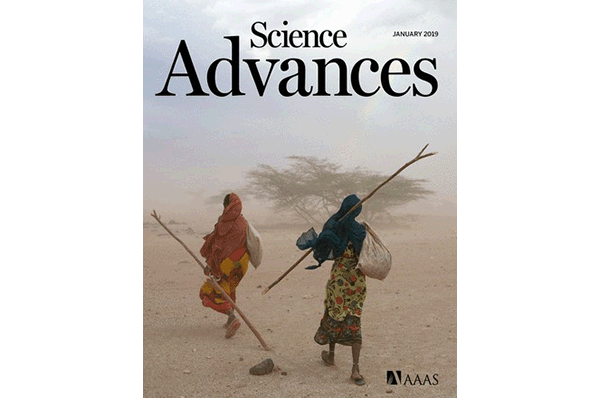News 2019
Archives: 2024 | 2023 | 2022 | 2021 | 2020 | 2019 | 2018 | 2017
News Archives 2019
Ocean Bounty on TV3 featuring Cawthron Institute
December 2019: On TV3, Graeme Sinclair follows the lifecycle of one of New Zealand’s most delicious delicacies, Te Matuku Oysters, from the Cawthron Aquaculture Park to the table. The Cawthron Institute support the oyster industry with a selective breeding programme which enables more resilient, beautiful oysters. A must see for the oyster lovers out there 🦪.
Serean Adams, Aquaculture Group Manager, Cawthron Institute. Image: TV3 Now.
Connections 27 out now
December 2019: A round up of research news from New Zealand's independent research organisations:
- Malaghan: NZ’s first CAR T-cell cancer therapy clinical trial underway
- Cawthron uncovering high-value nutrition in NZ’s kaimoana
- MRINZ research may change how ICUs use oxygen
- BRANZ: Tackling mental health
- Southland’s Waihopai River most improved in Cawthron's River Awards
- Lincoln Agritech research on braided rivers
- Stellar year for young LASRA researcher
- PlantTech examines food future
- Cawthron investigates red seaweed to reduce agricultural GHG
- TiDA 3D metal printing now only limited by imagination
- Who doesn’t wear a seat belt?
- Bragato Research Winery update
- Motu: Digital inclusion and wellbeing in New Zealand
Catherine Maidment. Photo: LASRA.
IRANZ news briefs
December 2019: News snippets from NZ's independent research organisations.
- IROs meet Dr Parmjeet Parmar
- Speaker’s Science Forum "Food for Thought"
- CRL Energy becomes Verum Group
- Lincoln Agritech researchers present and discuss research in Denmark
- BRI: Mealybug and Leafroll
- BRI: Hawke’s Bay hailstorm response
- Two new team members join HERA
- LASRA awards to top performing leather science students of 2018
- Appointment recognises growing importance of functional foods
- Malaghan Institute hosts Prof Katharina Gaus
- MRINZ data management strategies on the world stage
- Motu: A+ student wins Sir Frank Holmes Prize in 2019
- Motu’s John McDermott wins NZIER Economics Award
From left, Dr Alex Semprini, MRINZ, Dr Mark Begbie, PlantTech, Dr John Bright, Aqualinc, Dr Parmjeet Parmar, National Spokesperson RS&I, Dr Rob Whitney, IRANZ, and Dr Troy Coyle, HERA. Photo: Brian Low, HERA.
A new source of Sentinel imagery: Xerra Gateway
December 2019: In an amazing leap forward in satellite imagery access, anyone can access the Sentinel satellite imagery of New Zealand, which includes the satellite data archive, by visiting gateway.xerra.nz and creating a free login. From there it is easy to search and download images. Xerra Gateway is regularly updated with new imagery of New Zealand, often within six hours of the Sentinel satellite overpasses.
Dr Moritz Lehmann, Senior Scientist at Xerra, says the interface is easy to understand and that the large browse images provide an immediate impression of the suitability of the images. "One real advantage is that data from Xerra Gateway downloads way faster than from the Copernicus Hub hosted in Europe.”
Dr Lehmann is using the Sentinel images to monitor New Zealand’s lakes for water colour and the presence of cyanobacteria.
Xerra Gateway is built in partnership with Geoscience Australia and the European Union’s Copernicus Programme.
Sentinel satellite image of farmlands and river.
BBHTC: Medium-density living
December 2019: The BRANZ-hosted Building Better Homes, Towns and Cities (BBHTC) National Science Challenge has a research programme looking into what is working and what’s not for residents of two medium-density housing developments. The findings are useful as this building type is becoming increasingly popular.
Building Better Director Ruth Berry reviews the research in the latest issue of build magazine. She asks what happens when the new home shine wears off? "What do residents who have moved to medium-density housing think about their new homes? What works well and what, with the benefit of hindsight, would they change or improve? What advice would residents give to designers and builders to allow them to deliver even better medium-density housing? And does living in medium-density housing deliver a high quality of life?"
Medium density housing development at Hobsonville Point. Photo: Errol Haarhoff, BBHTC.
BRANZ: Tackling mental health
December 2019: Figures released by the Coroner show over 685 New Zealanders died by suicide last year, the highest number on record. With rates in the construction industry high, action is being taken to bring change.
In the latest issue of build magazine, Chris Alderson, CEO of Construction Health and Safety New Zealand, writes about mental health in the construction industry with the launch in early December of the BRANZ pocket guide to mental health.
"BRANZ Study Report 411 Mental health in the construction industry was the first New Zealand-specific research on mental health in construction. Published in 2018, it opened an urgent conversation about the extent of suicide in the sector. On average over the last 10 years, three times more people have died by suicide than in workplace accidents. This has galvanised the industry into action."
The cover of the BRANZ pocket-guide "How to have a conversation about mental health". Photo: BRANZ.
Who doesn’t wear a seat belt?
December 2019: Between 2006 and 2016, non-use of seat belts accounted for up to 30% of motor vehicle road deaths in New Zealand. In addition to increased risk of death, there is also an obvious increased risk of serious injury for occupants who did not wear a seat belt in a crash. So who doesn’t wear a seat-belt and why?
Newly published research by Lily Hirsch, Hamish Mackie, and Richard Scott from Mackie Research, John de Pont from TERNZ, and Simon Douglas and Dylan Thomsen from the AA Research Foundation looks at the profiles for non-users of seat-belts.
“In New Zealand, these potentially preventable deaths are not decreasing. It is important to understand the factors associated with crashes where seat belts are not worn,” says Mackie Research Director Dr Hamish Mackie.
In New Zealand, potentially preventable deaths are not decreasing. IRANZ researchers from TERNZ and Mackie Research develop five distinct profiles of seat belt non-users. Photo: Pexels.
Bragato Research Winery update
December 2019: After two years of vision, planning and preparation, the new Bragato research winery building in Marlborough has come on in leaps and bounds in the past couple of months. The concrete has been poured, frames erected, and panel installation has just commenced.
In late October, the BRI Research Winery was registered with the New Zealand Green Building Council (NZGBC). Once certified, it will be the first in Marlborough to be sustainably-built to a five-star rated standard.
A five-star rating requires the building to adhere to certain sustainability and environmental standards. The research winery design was rated under building management, internal environmental quality, energy, transport, water, materials, land use and ecology, emissions, and innovation.
Villa Maria donated three tōtara cuves from their Esk Valley Winery in the Hawkes Bay to BRI. The timber from the cuves will be used to make a table for the research winery conference room. Photo: BRI.
TiDA 3D metal printing now only limited by imagination
November 2019: TiDA in Tauranga can print big. Really big. Having recently commissioned New Zealand’s first Wire Arc Additive Manufacturing (WAAM) system, which prints large metal parts from low-cost welding wire, TiDA Chief Executive Dr Mike Fry says what they can print now is only limited by the imagination.
“WAAM is for larger, heavier, less finely detailed objects than our other established 3D printing processes – stuff you wouldn’t want to drop on your toe. WAAM offers new flexibility for manufacturing industrial, architectural and sculptural items,” says Mike.
To prove the point they printed up an 11kg Roman amphora – the vessel is impressively beautiful and used only $33 worth of mild steel.
TiDA’s WAAM system printing a three-into-one pipe junction. The pipe junction used 14.5kg of steel wire and 20 hours of print time. Photo: TiDA.
Motu measuring the “gig” economy
November 2019: In late November, Motu released research exploring how to go about measuring gig work. "Gig" once meant a live performance by a musician or group. It now refers to any work that is temporary or that has an uncertain future.
While there’s no set definition of gig work, it can include people who drive for Uber, sell things on TradeMe, or rent out bedrooms on AirBNB, alongside other temporary workers.
The prominence of digital platforms and the apparent ease with which they allow gigs – short-term arrangements between those wanting to purchase labour and those wanting to sell it – has ignited concerns of a future in which gig work is more prevalent or even substantially replaces more traditional employment.
Traditional employment measures also do not necessarily capture gig work well and relatively little is known about its extent.
People who drive for Uber are considered "gig" workers. Photo: Robert Anasch, UnSplash.
Digitisation: the future of steel fabrication
November 2019: This latest podcast from HERA interviews Watkins Steel Managing Director Des Watkins about the changes his steel fabrication company has made.
"Steel fabrication by its very nature is a very traditional, very conservative industry. We're one step away from being a blacksmith - we cut, bend, and weld. Nothing much has changed. To separate ourselves from everyone else we had to do something different."
Des has gone through a transformative process in his steel fabrication business – developing a four-step end-to-end digital process utilising 3D scanning, digital twins, augmented reality, and automation.
This change has allowed him to achieve real world outcomes that have redefined his business.
Des will also to be a keynote speaker at HERA's Future Forum 20/20 VISION conference next year.
Watkins Steel Managing Director, Des Watkins. Photo: HERA.
Malaghan scientists recipients of Research for Life funding
November 2019: Prostate cancer is one of the newest areas of cancer research at the Malaghan Institute. Professor Antony Braithwaite, who received a $11,000 grant from Research for Life in its latest round of funding, heads the University of Otago’s Cell Transformation Laboratory. He joined the Institute as a visiting scientist in March 2019 to leverage Malaghan's unique research technology to investigate the underlying mechanisms behind prostate cancer, to better understand the genetic, environmental and immunological factors that contribute to this disease.
Research for Life grants not only cover the Institute’s growing prostate cancer research space, they are also supporting two other young researchers to present their research at international conferences.
The Malaghan Institute. Photo: Malaghan Institute.
Stellar year for young LASRA researcher
November 2019: It has been a stellar year for New Zealand Leather and Shoe Research Association’s (LASRA) Catherine Maidment, following on from winning this year’s Young Scientist Leather Grant for leather research from the International Union of Leather Technologists and Chemists Societies Research Commission (IUR) for basic science, the young researcher has just finished her Master's thesis from Massey University. In her thesis, on ‘Investigating the molecular building blocks of loose and tight cattle hide’, she provided a clear, comprehensible and up-to-date description for loose and tight hides using powerful molecular and structural techniques including microscopy and high-resolution mass spectroscopy.
Catherine Maidment is currently investigating the collagen structure of different species. Photo: LASRA.
HERA supporting new engineering ideas
November 2019: HERA was a sponsor of the final year student project events for both the University of Auckland and Auckland University of Technology (AUT) this year.
HERA Research Engineer Hafez Taheri was one of three judges assessing individual projects. Each project was reviewed on visual features, poster display, novelty of work, depth of content, significance, knowledge base, and accuracy of research.
“I was very impressed with the projects I was able to review as they were full of new and innovative ideas which reflected the students’ great perception towards technology. The students’ ability to utilise their knowledge during presentations was excellent and the two awarded projects for our HERA prize outshone others.”
Engineering posters on display at the recently held AUT Engineering Student Project Exhibition and Awards. Photo: HERA.
Southland’s Waihopai River most improved in Cawthron's River Awards
November 2019: Environment Southland’s Waihopai River took out the Supreme Award for Most Improved River at the New Zealand River Awards 2019.
Two decades ago, Invercargill had turned its back on the Waihopai River and referred to it as ‘the drain’. Its flat catchment had been drained to make way for intensive farmland and in the lower reaches the river was barricaded in to protect the city from flooding. The accumulated effects of steep and eroding drainage banks, nutrient losses from farming, stormwater discharges contaminated with sewage and other industrial contaminants led to a river in a poor state.
But, since 2006, extensive changes and ongoing management have had a marked positive impact on the health of the Waihopai River.
Riparian planting along the Waihopai River.
LASRA to host international conference in Queenstown
November 2019: The New Zealand Leather and Shoe Research Association (LASRA) recently learned that their bid to host the next Asian International Conference of Leather Science and Technology in 2022 was successful.
“Dr Sujay Prabakar made the pitch on our behalf to the organising committee in Dresden, and with a little help from Tourism NZ, we later were informed our bid was successful. We will be hosting the three-day conference in Queenstown in 2022 – seems a long way off, but there is much to be done between now and then,” says LASRA Director Geoff Holmes.
Tourism New Zealand Business Events National Awards Dinner. Tourism New Zealand assisted LASRA with the bid. Photo: LASRA.
MRINZ: Richard Beasley awarded Beavan Medal
November 2019: His research helped halt an epidemic of asthma deaths in New Zealand and has gone on to change the way the world manages asthma, saving hundreds of thousands of lives in the process.
World-renowned asthma researcher Professor Richard Beasley was awarded the Health Research Council of New Zealand (HRC) Beaven Medal at the Royal Society Te Apārangi Honours event in October for the huge impact he has had on treating and managing asthma.
Professor Beasley founded and directs the Medical Research Institute of New Zealand (MRINZ) in Wellington.
Professor Richard Beasley. Photo: University of Otago, Wellington.
NBRTV: Economically Speaking
November 2019: Motu's Executive Director John McDermott looks at NZ's economy with the impact of falling interest rates on NBRTV's Economically Speaking.
What can the Reserve Bank do if the monetary policy loses its effect, as interest rates get near zero? In his latest NBR column, John looks at the options. This item requires an NBR subscription to view, but a snippet of the interview is available on Twitter - Click on John's photo to view.
Motu's Executive Director John McDermott on NBRTV
PlantTech examines food future
November 2019: PlantTech CEO Dr Mark Begbie recently attended Horticulture NZ’s 2019 conference - contributing to the discussion about the emerging use of technology in horticulture and how the widespread application of drones, robotics, and imaging would become easier and more affordable over time.
"The pace of change has been described as being similar to the principle of Moore’s Law, which states that the speed and capability of computers can be expected to double every 18 months. It would appear that these developing technologies are on a very similar trajectory."
Mark says from PlantTech’s perspective, greater crop diversification in mosaic landscapes are all opportunities for further exploration. Photo: John Lambeth, Pexels.
Digital inclusion and wellbeing in New Zealand
November 2019: Senior Fellow at Motu Research Professor Arthur Grimes examines which groups have a lower likelihood of being digitally included in New Zealand. He also examines the impact of digital inclusion on waiora or wellbeing - it turns out there is a sweet spot, too little or too much internet access can reduce wellbeing.
Using four large-scale surveys of New Zealanders that include information on internet availability, researchers at Motu found that a number of identifiable groups are prone to relatively low access to the internet, including people living in social housing and those with disabilities.
Senior Fellow at Motu Research, Professor Arthur Grimes. Photo: Motu.
MRINZ research may change how ICUs use oxygen
November 2019: MRINZ research may soon change how intensive care units use oxygen to support patients around the world.
The research found that ICU patients are being given unnecessary levels of oxygen that make no difference to their recovery, and in some specific groups less oxygen may actually improve recovery and survival rates.
The research team is now planning further investigation into these patients using more targeted trials.
A publication of the research is available in The New England Journal of Medicine (linked below).
MRINZ research may soon change how intensive care units around the world use oxygen to support patients. Image: Dr Ciléin Kearns, MRINZ.
Xerra success in joint Endeavour Fund bids
November 2019: In collaborative bids, Xerra has secured MBIE-funding to support what the government refers to as “excellent research proposals that will provide the highest impacts”.
One proposal that got the green light is a $1M Smart Ideas project to help develop new 3D-change maps of New Zealand. Xerra’s Principal Scientist, Dr Dave Kelbe, will be supporting the University of Otago, along with GNS Science, Land Information New Zealand and Meridian Energy.
The other proposal that Xerra will be supporting is the Forest Flows project, a $13.7M Research Programme led by Scion. Its aim is to figure out exactly how planted forests impact our water.
A new research programme involving Xerra will develop a fast and accurate way to measure how much water is used by, evaporates from, or flows through planted forests, leading to better management of our natural resources. Photo: Brandon Montrone, Pexels.
Big changes in NZ work and living locations
October 2019: Research released earlier this month by the Productivity Commission shows how New Zealanders have experienced big changes in the jobs they do and where they do them.
The report, co-authored by Motu's Dave Maré, says these changes reflect changes in industries where people work. Between 1976 and 2013 employment in manufacturing declined from 25% to 10% of the workforce. In contrast, there was significant expansion of professional services, health and education, accommodation and hospitality, and financial services. Similar trends have been seen in most developing countries, with manufacturing employment declining from 32% of the workforce in 1950 to 9% in 2010 in the United States.
Service job increases saw a reallocation of jobs away from smaller centres to main cities. For smaller cities and towns, the presence of good amenities, such as good climate or attractive scenery, became more important as manufacturing and primary production became smaller shares of the economy.
Image: Productivity Commission.
Cawthron investigates red seaweed to reduce agricultural GHG
October 2019: Cawthron Institute, in collaboration with researchers from the University of Waikato and leading Australian macroalgal scientist, Professor Rocky de Nys, is researching whether a native red seaweed (Asparagopsis armata) could be a game changer for the agricultural sector.
The seaweed, Asparagospis armata, has already been proven in trials overseas to reduce greenhouse gas emissions in livestock by up to 80 percent.
The research carried out in Australia has shown that the seaweed, once harvested and dried, can be used as supplementary feed for livestock, and estimates that if just 10 per cent of global ruminant producers used Asparagopsis as an additive to feed, it would have the same impact for our climate as removing 50 million cars from the world's roads.
The seaweed, Asparagospis armata, could reduce greenhouse gas emissions in livestock by up to 80 percent when used as an additive to their feed. Photo: Cawthron Institute.
Lincoln Agritech research on braided rivers
October 2019: A new five-year research programme is aiming to help regional councils manage their water resources and meet the Government’s freshwater quality standards by 2025.
Lincoln Agritech Ltd has been awarded almost $8m in New Zealand Ministry of Business, Innovation and Employment (MBIE) funding for the research programme, which will provide the first accurate information about how much water is lost from braided rivers into groundwater.
“Braided rivers are unusual worldwide, but very important in New Zealand because of their provision of natural habitat, sources of agricultural and drinking water, and their recreational use,” said Programme Lead Scott Wilson, Lincoln Agritech Hydrogeologist.
Peter Davidson, left, Marlborough District Council Groundwater Scientist and Scott Wilson, Hydrogeologist, Lincoln Agritech. Photo: Lincoln Agritech.
BRANZ postgrad scholarships
October 2019: BRANZ welcomes applications for postgraduate scholarships to begin in 2020.
Their scholarship programme is for postgraduate students undertaking research that inspires the building and construction industry to provide better buildings for New Zealanders.
Allocations are $20k for a Masters, or up to $25k p.a. (for up to three years) for a PhD. Applications should be sent to the email below by 2 December 2019.
For enquires or to submit an application email research@branz.org.nz.
Under constuction. Photo: Louise Thomas.
Malaghan: NZ’s first CAR T-cell cancer therapy clinical trial underway
October 2019: New Zealand’s first clinical trial of CAR T-cell therapy, a revolutionary new approach to fighting cancer, is getting underway after receiving final regulatory approval.
The phase I safety trial, called ENABLE, is part the of the Malaghan Institute’s research and development of a new version of CAR T-cell technology, in partnership with Wellington Zhaotai Therapies Limited. The trial will involve up to 12 participants with certain types of relapsed and refractory B-cell non-Hodgkin lymphoma who have exhausted other treatment options.
Malaghan Institute Clinical Director Dr Robert Weinkove says the production of CAR T-cells is a major step in the development of the Institute’s cell therapy capabilities.
“For this early phase safety trial of a new type of CAR T-cell therapy, we’ll be manufacturing the cells in the dedicated cell therapy suite at the Malaghan Institute in Wellington."
Photo: Malaghan Institute of Medical Research.
Cawthron uncovering high-value nutrition in NZ’s kaimoana
September 2019: The High-Value Nutrition (HVN) National Science Challenge has announced funding for novel research to develop the innovation capacity of Māori food and beverage businesses. Cawthron Institute is leading the “He tipu moana he oranga tangata: Revealing karengo as a high-value functional food” programme in collaboration with Te Rūnanga o Ngāi Tahu and Wakatū Incorporation, and will investigate the potential of a modern high-value industry based around karengo, a type of native edible seaweed.
Research lead and scientist, Dr Tom Wheeler from Cawthron Institute’s Analytical Science Group, is looking forward to learning more about the composition of this traditionally important kai and Māori dietary supplement, and says that he is excited by the opportunity this research represents for New Zealand.
Research lead and scientist, Dr Tom Wheeler, from Cawthron Institute’s Analytical Science Group. Photo: Cawthron Institute.
Connections 26 out now
September 2019: A round up of research news from New Zealand's independent research organisations:
Meeting with the Minister
HERA: The change leader
Mackie Research: Innovating Streets for People
BRANZ: Performance of precast concrete floors
Aqualinc aids drainage solutions in Kaikōura
Lincoln Agritech: Future of farming at Kowhai farm
PlantTech: Reaping the rewards of innovative thinking
Bragato breaks ground at new research winery
Lincoln Ag: Sensing sub-surface structures
Motu research aims to help identify future recessions
Ground-breaking MRINZ study to transform asthma treatment
Malaghan: Gut worms to treat cancer?
And more!
Sept IRANZ news briefs
September 2019: News snippets from New Zealand's independent research organisations.
- BRANZ: Energy-flexible buildings
- Motu: Friendlier skies a win-win solution
- Xerra: Pressures on lake ecosystems
- TiDA: Spin-off company RAM3D from prototypes to full scale production
- Bragato welcomes new research manager
- HERA welcomes Senior Welding Engineer
- PlantTech welcomes new research scientists
- LASRA PhD student wins big in small comp
- Cawthron Institute finalist in KiwiNet
- MRINZ "Curiosity Mondays"
Follow the link for more details on the September 2019 news briefs from our Independent Research Organisations.
A titanium hip replacement, printed by RAM3D. RAM3D has been ramping up its metal 3D printing to meet customer demand - installing a new tool-grade steel printer to its existing tech suite. Photo: RAM3D.
Meeting with the Minister
September 2019: In late August, the Minister of Research, Science and Innovation the Hon. Megan Woods met with IRANZ members at the Beehive. The meeting was an opportunity for IRANZ Chair Dr John Bright to express IRANZ’s appreciation for the Government maintaining stability in the science funding system, and for the way the R&D Tax Incentive has been introduced to New Zealand’s science system.
Dr Woods said there would be no big surprises in the R&D Strategy, and that research excellence and impact would continue to be the big driver for future-funded projects.
IRANZ executive members meeting with the Minister of Research, Science and Innovation the Hon. Megan Woods. From left: Peter Barrowclough, Wendy Turvey, Richard Capie, John Bright, Murray McCurdy, the Hon. Megan Woods, Irene Braithwaite, John McDermott, Robert Matheson, and Rob Whitney. Photo: Louise Thomas.
WSP Opus: Inspiring tomorrow’s innovators
September 2019: More than 80 students from Innovative Young Minds toured WSP Opus’s Research centre in Petone, going behind the scenes to learn more about the experimental research that is carried out at WSP Opus.
Innovative Young Minds is a pioneering initiative by Hutt City Council and Rotary Hutt City to encourage more young women to explore careers in science and technology.
“We felt very privileged to be able to visit the centre and see a handful of the thousands of jobs carried out there. Getting to talk to the engineers and scientists was incredible, they were all lovely people, and each of them said no two days are alike; something I want in my future career.”
Neil Jamieson, WSP Opus Research Leader Road/Vehicle Interaction, explains to the students from the Innovative Young Minds programme how a model of Wellington is used to demonstrate the effects of wind on various building clusters. Photo: WSP Opus.
Aqualinc aids drainage solutions in Kaikōura
September 2019: Aqualinc is assisting the Kaikōura Plains Recovery Project (KPRP) with drainage solutions on a number of farms around Kaikōura. The 2016 earthquake centred in Kaikōura caused extensive land damage, with land movements causing significant changes in local hydrological conditions. Many pastoral areas became waterlogged and unproductive as a result.
The team from Aqualinc, including Dr Helen Rutter, Ian McIndoe, Rose Edkins, Dan Farrow, and Justin Legg, have been assessing the likely sources of the water, determining water quality and flows, and developing drainage plans to remediate the land, with the aim of bringing it back into productive use again, while minimising impacts on existing local streams and rivers.
A sediment sump at the terminus of a trench to stop sediment running off into surface waterways. Photo: Aqualinc.
Innovating Streets for People
September 2019: Hamish Mackie from Mackie Research says that when people think of great street design it is never about traffic-clogged streets or even good parking, but about quality urban places which are safe and attractive for walking, cycling, and spending time and money. This means greenery or water, lighting, walkways, cycleways, art, cafes, and slow traffic. Spaces for people.
Mackie Research has been working with the NZ Transport Agency on a project called Innovating Streets for People, a project that aims to make street innovation projects around New Zealand easier to implement. The Government Policy Statement on Land Transport has signalled a shift in direction towards transport that is safer, more environmentally friendly, and gives communities better access to opportunities. As part of this, quality urban places are needed.
Temporary changes to make walking and cycling safer and easier on Federal Street in Auckland. Photo: Auckland Transport.
SkyTEM airborne electromagnetic surveys a first for NZ
September 2019: In February this year, the Critical Pathways Programme (CPP) team, including researchers from Lincoln Agritech and Aqualinc Research, introduced the world-leading SkyTEM system for airborne electromagnetic surveys to New Zealand.
The electromagnetic surveys captured at high spatial resolution characteristics of the subsurface environment so that researchers can study the flow of water, and contaminants transported by it, from a parcel of land to a surface water body.
Specifically targeting the relatively shallow and short transfer pathways operating at the sub-catchment scale (tens of km2) will allow researchers to create models capable of describing water flow and contaminant transfer at this important scale.
The team prepare to take up the SkyTEM system for airborne electromagnetic survey of the Piako River headwater catchment, February 2019. Photo: Aldrin Rivas, Lincoln Agritech.
The arrival of an alien
September 2019: Cawthron Institute Taxonomist Fiona Gower represented her team's research at a conference with a difference in early August. Fiona attended the 13th International Polychaete Conference on board The Queen Mary Ship, Long Beach, California, where she presented a poster, made in collaboration with researchers at NIWA New Zealand, about the arrival of an alien species of Polychaete in New Zealand.
Fiona writes that the new alien nereidid worm has progressively established itself in New Zealand waters since it was first detected in 2017.
Cawthron Institute Taxonomist Fiona Gower. Photo: Cawthron Institute.
Global networks tackle human health problems
August 2019: Global problems require global solutions. When it comes to global health issues, international medical research networks are vital. These cross-border collaborations and relationships between scientists, laboratories, and research organisations are essential for sharing knowledge, expertise, and resources to advance understanding and find cures for the most pressing diseases of our time.
Malaghan's upcoming CAR T-cell cancer therapy clinical trial is a partnership between the Malaghan Institute and the Chinese Hunan Zhaotai Medical Group. The trial combines cutting-edge CAR T-cell technology, developed in China, with Malaghan's expertise and capability in cell-based immunotherapy and experience with clinical trials. The collaboration will not only give New Zealanders early access to this revolutionary new treatment, but may ultimately improve the effectiveness of CAR T-cell technology for patients worldwide.
The Malaghan Institute tapping into a global network of medical research. Image: Malaghan.
BRI: The hidden bouquet
August 2019: What happens when we swirl and sniff our wine? What is the nose telling the brain? How does biology perceive chemistry? How does chemistry become joy?
When we are enjoying a nice glass of Sauv or Pinot, the olfactory neurons deep in our nose get activated by the different aroma compounds in the wine. These then relay a message to the brain cortex (the highest level of brain tissue) through electrical impulses. This happens in a series of two relay steps called a synapse, and it involves two neurons: the olfactory neuron (which perceived the smell), and a relay neuron called a mitral neuron, which then processes the information, and relays to the cortex.
Dr Matias Kinzurik writes about what our brain experiences when we sniff wine, and the importance of the wine's aroma. Dr Kinzurik is a Research Programme Manager at the Bragato Research Institute (BRI). He manages the Pinot noir Programme, a five-year wine research programme looking at further understanding Pinot noir wine quality, and how it can be produced at high yields.
Wine aroma molecules enter through the nose and react with olfactory receptors in the olfactory bulb (orange), which connects to the cortex (blue). Image: Dr Matias Kinzurik, BRI.
The change leader
August 2019: HERA CEO Troy Coyle brings fresh thinking and progressive ideas about leadership to a metal industry-based association not previously seen as forward looking. #Timesarechanging.
"I am a big supporter of the Four Capitals Framework [human, financial, environmental and manufactured capital that must be in balance for a sustainable society]. I believe that all leaders should be evaluating business performance more broadly than simple profitability. Now is the most important time in history to look at environmental performance," says Troy Coyle.
Troy also says that leaders should resist the urge to focus on optimising business as usual and create a game plan for disruption. This may mean taking the risk of disrupting your own business.
HERA CEO Troy Coyle. Photo: Louise Thomas.
Ground-breaking MRINZ study to transform asthma treatment
August 2019: New findings from a ‘landmark’ New Zealand study have provided the compelling evidence needed to change how doctors treat the world’s most common respiratory illness.
Around 10-15% adults worldwide suffer from asthma – 1 in 6 New Zealanders (around 830,000) live with the disease daily. Now a new, fully independent study of nearly 900 New Zealand patients with mild to moderately severe asthma, conducted by the Medical Research Institute of New Zealand (MRINZ), has found that a simplified, combined inhaler treatment cuts the risk of severe asthma attacks by one third compared to other commonly prescribed treatments.
The study was fully-funded by New Zealand’s Health Research Council (HRC) and published in the prestigious Lancet medical journal.
MRINZ Director Professor Richard Beasley. Photo: Otago University Wellington.
Motu research aims to help identify future recessions
August 2019: Before the Global Financial Crisis (GFC), a ‘normal’ rate of insolvencies in New Zealand involved about 13 businesses failing every year. Failures ranged from large corporates usurped by innovative upstarts to businesses whose product didn’t survive the test of the market.
“We know that periods of macroeconomic turbulence are difficult to navigate for businesses, but there is little research on how this affects firms in New Zealand,” says Dr John McDermott, Executive Director of Motu Economic and Public Policy Research.
“It is my hope that our new research will help New Zealanders understand the dynamics of the macroeconomy. In particular, it could potentially be useful in identifying the probability of future recessions and identifying their severity early on.”
Businesses are more likely to fail in recessions as costs rise sharply relative to output prices. Photo: Ryan Tang/Unsplash.
BRANZ: Performance of precast concrete floors
August 2019: A national research programme looking into precast concrete floor performance in earthquakes is likely to result in revised guidelines for seismic assessment and retrofit of buildings with precast floors.
Concrete buildings represent over 80% of existing commercial buildings in New Zealand cities, and most have precast floors.
The partial collapse of precast concrete floors in Statistics House in Wellington during the 2016 Kaikōura earthquake sparked serious concerns about the seismic performance of precast floors. Various initial investigations concluded that urgent research into seismic assessments and retrofit guidance for existing buildings with precast floors was required. This led to a BRANZ project investigating the seismic performance of buildings with precast floors, which became a catalyst for an ongoing three-year national research programme called ReCast, led by Professor Ken Elwood from the Faculty of Engineering at the University of Auckland.
LASRA scientists present at IULTCS Congress
August 2019: This year's biennial IULTCS International Congress in Dresden saw a team of four scientists from New Zealand's LASRA presenting their leather research to 450 delegates from 35 countries. This year’s programme highlighted advancements in leather science and technology, industry, material testing, performance and applications, and sustainability. The theme of the Congress was ‘Benign by Design’ – a principle in many green chemistry and sustainability initiatives.
LASRA scientists gave three oral presentations and one poster presentation. The oral presentations were: "Biotechnology for environment-friendly leather production"; "Towards a molecular level understanding of chrome tanning"; and "Strong skin, not always thick: Comparative structural and molecular analysis of deer skin and cow hide".
Further details of the papers are available on the LASRA website.
LASRA's Dr John Liu presented a paper on "Biotechnology for environment-friendly leather production". Photo: LASRA.
PlantTech: Reaping the rewards of innovative thinking
August 2019: An innovative handheld Pulse meter, developed by Tauranga company Blue Lab in collaboration with Lincoln Agritech, is taking the horticultural industry by storm.
The product led to Bluelab, a founding shareholder of the new Regional Research Institute PlantTech, being announced as a NZ Hi-Tech Awards finalist twice in 2019, and receiving recognition in the ‘Most Innovative Hi-Tech Hardware Product’ and ‘Most Innovative Hi-Tech Agritech Solution’ categories. The Pulse meter later went on to receive the ‘Excellence in Innovation’ award at this year’s BoP Export NZ Awards.
Pulse is a handheld meter specifically designed for use in the hydroponics and horticultural industries. Measuring moisture levels, electrical conductivity and temperature in media, the sensor provides fast, accurate root zone measurements, sending data directly to mobile phones to better support growers with checking on crop health.
Pulse collecting data to measure crop health. Photo: PlantTech/Blue Lab.
Malaghan: Gut worms to treat cancer?
August 2019: Newsroom science reporter Farah Hancock reports on a Malaghan Institute of Medical Research medical trial looking at how hookworms affect healthy people. The approach could pave the way for hookworm prescriptions to help or prevent conditions from Crohn’s disease to cancer.
Amazingly, the trial received more than enough volunteers just days after it was announced in late July. A possible reason for the trial’s popularity, despite trialists acting as a parasite host, is the theory of beneficial worms has been around for awhile and flourishing on social media.
“There is a significant unregulated industry for helminth therapy, involving people self-medicating for serious allergic and autoimmune conditions. We want to do the groundwork to ensure the safety and effectiveness of this type of treatment,” says Malaghan's Head of Laboratories Mali Camberis.
Professor Graham Le Gros and Mali Camberis. Photo: Malaghan Institute.
Future of farming at Kowhai farm
August 2019: An NZ Internet of Things (IoT) Alliance arable farming technology trial at Lincoln University’s Kowhai farm has seen Lincoln Agritech partner up with three other tech companies to form the “Tru Track” consortium.
Blair Miller from Lincoln Agritech says that 16 sensors were deployed around the farm, each hooked up to the internet and providing data in real-time.
“Each sensor provides valuable data that supports the arable farming operation on site,” says Blair.
“The sensors monitor and generate important data such as weather conditions, plant health, soil moisture, and nitrate levels, which can then be used to support actions by the farmer [based on real-time useful data]."
Blair Miller at Kowhai Farm. Photo: Melissa Wong, Lincoln Agritech.
Cawthron: 2019 KiwiNet Awards Finalist
August 2019: The Cawthron Institute, along with industry partners Sanford and SPATnz, are finalists in the 2019 KiwiNet Research Commercialisation Awards PWC Commercial Impact Category, for their research into transforming mussel aquaculture through hatchery technology and selective breeding.
Cawthron senior scientist, Dr Nick King, discusses the challenges of using selective breeding in a marine environment, compared to on land.
MRINZ: Taking Charge after Stroke
August 2019: Dr Vivian Fu, a student at the Medical Research Institute of New Zealand (MRINZ) recently presented her exciting PhD research “Taking Charge after Stroke“ at the European Stroke Organisation Conference. Her research is on a simple but effective intervention, which improves patient quality of life, ability to live independently, and to perform activities of daily living.
Traditionally stroke research has focussed on the hyper-acute management, in the belief that intervention early on makes the most difference to stroke outcomes. Many rehabilitation programmes have been developed in the past 10 years, but none have demonstrated improvements to independence or quality of life.
On 16 July, Dr Fu had her PhD accepted in full by Victoria University of Wellington.
Dr Vivian Fu after having her PhD accepted. Photo: MRINZ.
Cawthron: Open ocean farming
August 2019: Scientists at Nelson's Cawthron Institute are trail blazing new thinking in how farming in the open ocean might be possible. They call it the "new frontier" in aquaculture, where large areas of consented space were available but farming was challenging in exposed and dynamic waters.
Read this Radio New Zealand article by reporter Tracy Neal which covers Jim Sinner's talk at the Open Oceans Aquaculture Symposium in Nelson this month. Jim is a senior scientist in the coastal and freshwater group, and also a science leader for social science at the Cawthron. His talk covers how the move to open ocean farming might be perceived by iwi, environmental groups, and others who treasured the open ocean.
Mussel farming. Photo: Cawthron Institute.
Study shows Gisborne quality of life average
August 2019: Reporter Andrew Ashton from the Gisborne Herald examines the implications for Gisborne from Motu's Research for the Building Better Homes, Towns, and Cities National Science Challenge.
At the time of the 2013 census, Gisborne was ranked around the middle of urban areas in New Zealand for quality of life and quality of business. 'Natural’ factors such as climate have a positive impact on quality of life of places, but the study shows that Gisborne has room to improve in the quality of life and quality of business on offer to residents and prospective newbies.
Andrew interviews Motu's research programme leader Arthur Grimes to get his views on where to from here for Gisborne.
Moving for business or for fun?
July 2019: A new study from Motu Economic and Public Policy Research for the Building Better Homes, Towns, and Cities National Science Challenge uses a deep-dive analysis of census rent and wage data to look at whether people choose to move to locations with better quality of life or better quality of business.
Locations with a high quality of life attract migrants from other urban areas, but do not attract international migrants. Locations with a high quality of business do not attract domestic (urban or rural) migrants, but do attract international migrants.
“A one standard deviation increase in a location’s quality of business is estimated to increase international migration into that location by approximately one-third, while raising domestic residents’ migration out of that location by approximately one-fifth,” says programme leader Dr Arthur Grimes.
Do people choose to move to locations with better quality of life or better quality of business? Moving. Photo: Mike Bird from Pexels.
NZ at forefront of Earth observation tech
July 2019: What is Earth observation? And why is it important to New Zealand? Listen to Xerra Earth Observation Institute's Dr Moritz Lehmann, with Jesse Mulligan on RNZ Afternoons, talk about Earth observation (EO), and the value it brings to New Zealand and the world.
Tekapo false-colour satellite image. Photo: Xerra Earth Observation Institute.
Bragato announces new research winery
July 2019: Bragato Research Institute (BRI) has announced its national Research Winery will be built in Blenheim.
“We’re delighted to be able to announce our location at the Marlborough Research Centre on the Nelson Marlborough Institute of Technology campus alongside Plant and Food Research, New Zealand Winegrowers, and Wine Marlborough. The Marlborough Research Centre has been a key supporter of our establishment from day one and I’m pleased the vision – to be co-located with key research and industry organisations – will become reality,” says MJ Loza, CEO of Bragato Research Institute.
With capacity for over 100 research fermenters, the facility will enable more of the industry’s research trials to extend to look at possible impacts on finished wines. The Research Winery will trial winery equipment and technologies, winemaking processes, and sustainable winemaking and winery operations.
Bragato's new Research Winery to be developed. Image: Bragato Research Institute.
Medium-density housing technical issues
July 2019: A new report by Anne Duncan and Michael Nuth at BRANZ examines the technical issues associated with medium-density housing (MDH) from the perspective of New Zealand's building and construction industry.
As New Zealand's population and appetite for buying houses has increased, in some metropolitan areas space for new detached housing developments has declined. Medium-density housing in existing urban areas is a potential solution to halt urban expansion, and it could also be a part-solution for housing supply and affordability issues.
But the researchers write that there are some technical issues that can be barriers to providing quality medium-density housing in New Zealand.
Some of the technical issues identified and considered in the report include fire safety, pre-build and design, structure, weathertightness, and acoustics and noise.
Xerra: Water clarity improvements detected
July 2019: A team led by senior scientist Dr Moritz Lehmann at Xerra and the University of Waikato has published an analysis of 18-year trends in lake water clarity in the Rotorua lakes. Water clarity is an important indicator of water quality where better clarity typically indicates fewer contaminants.
What makes this study special is that it combines human observations, taken from a boat, with observations from 700 km above the Earth’s surface by satellites. This combination of data sources allowed the researchers to assemble a data record from 1999 to 2017 for 23 lakes, a data volume far greater than available using traditional ground-based methods.
"We found that water clarity significantly improved in nine lakes over the 18-year study period,” said Dr Lehmann, “Most trends in the other lakes were also found to be positive, but not statistically significant."
Water clarity is expressed as Secchi depth, which is the depth at which a Secchi disk (see picture) disappears from view when lowered into the water. Photo: Xerra.
Health checks for very special Northland lakes
July 2019: The New Zealand Herald has featured a research project to sample remote lakes, north of Kaitaia, which is being co-led by Dr Susie Wood from the Cawthron Institute. Susie says Northland has more than 400 dune lakes, and some of the rarest and most threatened aquatic habitats in the world.
The sampling is part of a nationwide project, Lakes380: Our lakes' health — past, present, future, aimed at determining the health and history of 10 per cent of New Zealand's 3800 lakes.
The Northland lakes project also involves New Zealand’s most northern iwi, Ngāti Kuri, and researchers from GNS Science. The project will use a range of new methods, such as environmental DNA and scanning techniques, to measure the current and past biodiversity of these globally distinct lakes.
Connections 25 Newsletter out now
July 2019: A round up of research news from New Zealand's independent research organisations:
Charles Eason - Companion of the New Zealand Order of Merit
HERA: Whanake Scholarship awarded
Lincoln Ag: Hitchhiking bacteria may hold key to contaminant clean-up
Measuring human rights around the globe
BRANZ: Post-disaster workloads
Government backs Malaghan’s cancer immunotherapy
MRINZ: Landmark study “a gamechanger” for asthma sufferers worldwide
Cawthron lab to test, research, and develop hemp products
Lincoln Ag: Sensing sub-surface structures
LASRA: Skin in the game
Kānuka honey treatment for cold sores
Rob Whitney - Companion of the Royal Society
And more!
New CEO and Chair at CRL
July 2019: CRL has a new Chair, Luc Bohyn, and Chief Executive Officer, Dr James Pope.
Luc is a former board member of New Zealand Coal and Carbon a West Coast mining company; he has a background in the European energy and materials markets.
James has a PhD in geochemistry, 20 years’ experience in the minerals industry, and has been with CRL for 16 years. Currently, James is involved in research related to mining environmental management, treatment of contaminated water from mining and agriculture, and geothermal geochemistry. He is a member of the AusIMM and NZ Geological Society, is adjunct to the Department of Geological Science at the University of Canterbury and the Great Lakes Institute for Environmental Research at the University of Windsor.
CRL is an energy, minerals, and environmental research and consulting company with laboratories in Wellington, Christchurch, Greymouth, and Hamilton.
Dr James Pope - after 16 years at CRL, Dr Pope has been appointed as the company's Chief Executive Officer.
July IRANZ News Briefs out now
July 2019: News snippets from our member research organisations around New Zealand.
- Regional Research Institutes Bragato, NZMMIR and PlantTech join IRANZ
- PlantTech officially launched by the Hon. Dr Megan Woods
- Aqualinc and HydroServices now located in one office
- Malaghan: Immune health a focus
- Motu: Commentary on the Zero Carbon Amendment Bill
- Malaghan’s Dr Weinkove features at TEDxTauranga
- MRINZ 'science connect' programme in primary schools
- Cawthron Institute hosting Open Oceans aquaculture symposium
Dr Peter Carey from Lincoln Agritech was interviewed by Radio NZ on his research into using catch crops to mitigate nitrate leaching during winter forage grazing. Listen to his 23 May RadioNZ Rural Morning Report interview at 1.54’. Photo: Lincoln Agritech.
Christchurch goes up and out
June 2019: "The earthquakes left a lasting impact on the Christchurch housing market. An early shortage of houses and rising rents has levelled out, and the city is experiencing population growth and stable housing prices," writes BRANZ Research Analyst Nick Brunsdon in an article recently published in build magazine.
Nick writes that the city is expanding outwards at an unpresidented rate, "with the CoreLogic estimates of the number of houses increasing by 1,239 in Halswell West and 1,875 in Wigram between 2010 and 2018.
"The most significant changes occurred outside the city as the population shifted towards the relatively stable land of neighbouring districts. In Waimakariri District, developments in Pegasus added 841 houses and 963 in Kaiapoi North East. To the south of the city, Selwyn District soon became the fastest-growing district in the country, with 3,392 houses added in Rolleston, 1,227 in Lincoln and 991 in West Melton."
LASRA: Skin in the game
June 2019: LASRA research scientists, Drs Sujay Prabakar and Rafea Naffa, were interviewed on their leather and hide research in an article, Getting deerskins in the game, published last week by Meat Exports NZ.
“In particular, we’re looking at how to minimise the use of chrome in the processing – currently a finished hide contains more than eight percent of it – while preserving the natural elements and increasing biodegradability," says Sujay.
Rafea’s work has focused on the extraction of the protein collagen, a major constituent of the hide comprising around 10 percent. In 2018, the collagen market accounted for nearly US$3.5 billion.
"[Collagen] is used in many applications, such as food and dietary supplements, medical devices, such as drug delivery, and wound healing and cosmetic formulations, such as anti-ageing and skin-rejuvenating ingredients.”
LASRA scientists, Drs Sujay Prabakar, left, and Rafea Naffa. Photo: MeatExportNZ, Ali Spencer.
Post-disaster workloads
June 2019: BRANZ research into post-disaster construction workloads has yielded some interesting insights into the Christchurch housing stock and has projected remaining workloads in the city.
BRANZ Research Analyst Nick Brunsdon writes about the research, which surveyed 335 Christchurch home-owners and landlords, in the latest issue of build Magazine. He writes that the sale of cash settled and unrepaired houses, termed ‘as is, where is’ has caused serious concerns. "These centre around the potential for these houses to be in poor or unhealthy condition due to earthquake damage and neglect. The lack of public record of insurance settlements also leads to concerns that they may be on-sold to unwitting buyers with only superficial repairs."
To shed some light on the ‘as is, where is’ market, the survey focused on the buyers of these unrepaired houses.
Cawthron lab to test, research, and develop hemp products
June 2019: Cawthron Analytical Science are offering their services to the growing hemp industry, following Ministry of Health approval for their laboratory to test, research, and develop hemp seed products.
Cawthron Analytical Science Business Manager Augusta van Wijk is enthused by the industry’s possibilities, “Hemp is increasingly being recognised for its food and nutraceutical benefits, and the industry is energised to make the most of emerging market opportunities. With our recently extended regulatory capability, we’re looking forward to working alongside growers and manufacturers to validate and innovate quality, compliant products for domestic and international markets.”
Rob Whitney - Companion of the Royal Society
June 2019: IRANZ Executive Officer Dr Rob Whitney has been made a Companion of the Royal Society of New Zealand Te Apārangi (CRSNZ) in recognition of Rob’s exceptional contribution to the promoting and advancing of science in New Zealand in a career spanning decades.
“Rob has made an outstanding contribution to the advancement of Independent Research Organisations in New Zealand, over many years and in a variety of roles,” says Dr John Bright, IRANZ Chair and Director of Research and Development at Aqualinc Research.
IRANZ Executive Officer Dr Rob Whitney has been made a Companion of the Royal Society of New Zealand Te Apārangi (CRSNZ). Photo: Louise Thomas.
Landmark study “a gamechanger” for asthma sufferers worldwide
June 2019: New findings from a landmark New Zealand-led study involving the Medical Research Institute of NZ have provided the missing evidence needed to potentially change the way doctors treat the world’s most common form of respiratory illness.
“The findings from this study are exciting and have the potential to be a gamechanger in the way doctors treat mild asthma,” says study author and MRINZ Director Professor Richard Beasley.
“The results provide new evidence supporting recent major changes in the management approach recommended in international asthma treatment guidelines.”
TVNZ's 1 News interviewed Professor Beasley about the recent research, which showed a combination inhaler could more than halve the risk of severe asthma exacerbations.
Lincoln Ag: Hitchhiking bacteria may hold key to contaminant clean-up
Research findings published in leading science journal
June 2019: Lincoln Agritech researchers and collaborators from various institutions in France have discovered a novel symbiosis involving a hitch-hiking magneto-sensing bacteria riding on the outer membrane of marine protists (microscopic single-celled organisms) found in sediment on the bottom of the Mediterranean Sea.
Lincoln Agritech Biotechnology Group (from left) Dr Richard Weld, Dr Johanna Steyaert, international intern Camille Vagner, Nicholas Glithero, PhD student Thomas Flinois, and Simon Lee. Photo: Lincoln Agritech.
LASRA joins Naturally Leather
June 2019: LASRA (New Zealand Leather & Shoe Research Association) has recently joined the membership of Leather Naturally, an industry-led initiative acting on behalf of the global leather industry.
Leather Naturally "promotes the use of globally-manufactured sustainable leather and seeks to inspire and inform designers, creators, and consumers about its beauty, quality and versatility". LASRA’s Director, Geoff Holmes, says this mission statement aligns closely to LASRA’s own role in guiding and supporting the industry in producing sustainably produced premium quality hides and skins.
Leather Naturally has just announced a USD 1.5 million dollar global campaign that will kick off this month. According to Campaign Manager Fernando Bellese the campaign will "help build a stronger image of leather and connect this incredible material with new consumers".
Genuine leather. Photo: Louise Thomas
Lincoln Ag: Sensing sub-surface structures
June 2019: Lincoln Agritech has announced a partnership with WNT Ventures to commercialise a range of advanced sensor technologies that could revolutionise the road construction sector among others. A new company, TDRI Limited, has been created to commercialise the technology, which has been licensed from Lincoln Agritech.
Lincoln Agritech has developed a range of remote and portable sensing technologies based on microwaves and the use of time domain reflectometry imaging (TDRi). TDRi can be used to precisely identify characteristics such as moisture patches within a medium, such as soil, allowing an insight into sub-surface structures that is simply not possible using traditional invasive ground sensors.
HERA: Whanake Scholarship awarded
June 2019: HERA have announced that Sarah Lewis is the inaugural recipient of the HERA Whanake Scholarship.
Sarah is studying a Bachelor of Engineering, majoring in mechatronics at Massey University in Palmerston North. She is also a graduate of the Puhoro STEM Academy.
"After meeting her on a recent trip to the rohe, I know she is the perfect candidate for our Whanake scholarship. Especially as we start our journey towards more meaningful engagement with Māori in Engineering," writes Troy Coyle.
HERA CEO Troy Coyle at Puhoro to meet HERA's new Whanake Scholarship Recipient, Sarah Lewis, and her support team. From left: Puhoro Kaihautū Kayla Martin, Troy Coyle, Sarah Lewis, Maori Education Trust General Manager Evelyn Newman, Puhoro Courtnee Matthews, and her baby Cairo.
Government backs Malaghan’s cancer immunotherapy
June 2019: Science Minister the Hon. Megan Woods announced on 13 June government backing for the Malaghan Institute's CAR T-cell cancer therapy programme, contributing up to $4.9M over 5 years – 40% of the estimated cost – to help establish CAR T-cell manufacturing in New Zealand and develop new CAR T-cell therapies for clinical use.
Malaghan Institute General Manager Mike Zablocki says the co-funding is a clear signal from the government that it sees a big future for human immune therapy.
“This is a growing, high tech, knowledge-intensive sector. This partnership funding will help transform our existing plans for a single phase I trial – already well underway – into a highly-focused programme of expanding economic opportunity for New Zealand."
Measuring human rights around the globe
Disabled, prisoners, and Māori vulnerable to human rights abuses in NZ
June 2019: While New Zealand has some positive scores for human rights, according to the Human Rights Measurement Initiative (HRMI), an international not-for-profit venture run out of Motu Research, we also have some strikingly poor results, particularly in terms of who is most at risk of rights abuses.
The HRMI has recently released data on the global human rights situation. The 2019 HRMI Human Rights Country Reports, with measurements tracking the progress of over 170 countries on at least some rights, includes 19 countries with extensive sets of civil and political rights data.
Measuring human rights. Photo: Louise Thomas.
HERA's Stephen Hicks appointed Professor of Civil Engineering at the University of Warwick
June 2019: After 11 years at HERA, General Manager Structural Systems Dr Stephen Hicks will be heading back to the UK to pursue a career as Professor of Civil Engineering at the University of Warwick.
Prior to work with HERA, Stephen worked in an environment where the steel industry was actively seeking to harmonize national standards with 27 other countries. New Zealand was a bit of a shock by comparison, we still had many of our own domestic standards rather than joint ones with our closest neighbour, Australia. It was no surprise, then, that this would set the tone for a strong standards focus during Stephen’s time with HERA.
Motu: NZ “under-adopting” win-win farming practices
June 2019: New Zealand farmers are apparently “under-adopting” multiple win-win pastoral farming practices that could reduce on-farm biological greenhouse gas (GHG) emissions. According to research, these practices can maintain, and in some circumstances even increase, farm profits. However, a new research paper from Motu says there are barriers to adopting these win–win practices (defined as “no-cost” mitigation practices).
Researchers from Motu have identified barriers affecting the adoption or expansion of no-cost mitigation practices by farmers in New Zealand. The researchers conducted interviews with farmers in different regions of the country. They discussed different managerial and practical implications of five different “no-cost” farming practices.
Charles Eason - Companion of the New Zealand Order of Merit
June 2019: Professor Charles Eason, CEO of the Cawthron Institute, has been appointed as a Companion of the New Zealand Order of Merit (CNZM) for his services to science and wildlife conservation in the Queen's Birthday Honours List.
“Charlie is fiercely passionate about science innovation and excellence, and has built Cawthron into one of the largest employers in Nelson Tasman and its success, which has a huge impact on our regional economy, is projected to continue thanks to Charlie’s leadership direction. The Board, along with Cawthron staff, are extremely proud of Charlie’s achievements and warmly congratulate him on this honour,” says Cawthron Institute Board of Directors Chair Meg Matthews.
Congratulations, Charlie, from all of us IRANZ!
Kānuka honey effective treatment for cold sores
May 2019: A unique pharmacy-backed trial, one of the largest medical studies of its kind ever undertaken in this country, has shown that honey derived from the New Zealand kānuka tree is just as effective in healing cold sores as standard pharmaceutical anti-viral treatment. The results from the Medical Research Institute of NZ were published in the prestigious British Medical Journal Open. They show that a New Zealand kānuka honey formulation Honevo (90% kānuka honey and 10% glycerin) is as effective as Viraban (5% aciclovir cream) in the time it takes to reduce pain and heal a cold sore.
Re-training our bodies to kill cancer
May 2019: Director of the Malaghan Institute of Medical Research Professor Graham Le Gros, spoke to nzherald.co.nz science reporter Jamie Morton about how immunotherapy has revolutionised how we treat cancer and a range of immune-related disorders.
"Difficult cancers in difficult organs that could never be reached by conventional therapy before are now being precisely targeted with immunotherapies. Asthma, allergy, gut disease – we're now finding that where the immune system is overreactive or oversensitive we can 'de-tune' it very specifically."
You can read more about the research on the Malaghan site or on the NZ Herald site linked below.
Bragato welcomes new independent directors
May 2019: The Bragato Research Institute (BRI) has announced the appointment of two new independent Board Members, Dr Dianne McCarthy CRSNZ CNZM, and Dr Bruce Campbell.
Dr McCarthy is the former CEO of the Royal Society of New Zealand, and is presently the Board Chair of the NZ Institute of Economic Research, a Director of the Cawthron Institute, on the governance boards of the Dodd-Walls Centre for Photonic and Quantum Technologies and the Healthier Lives National Science Challenge (NSC), and is the Chair of the Ageing Well NSC.
Dr Campbell is a recipient of the 2017 Prime Minister's Science Prize, the 2017 Horticulture New Zealand Industry Service Award, and the 2016 Royal Society of New Zealand Thomson Medal for outstanding leadership of agricultural and horticultural science.
Name change for CSST
April 2019: The Centre for Space Science Technology (CSST) has officially changed its name to Xerra. The Xerra Earth Observation Institute name signifies their focus on Earth Observation data and remote sensing technologies for the betterment of our regions and New Zealand as a whole.
Xerra is pronounced ‘zear-rah’ and originates from the latin word for Earth — Terra. The ‘x’ represents a multiplier. Xerra, then, is ‘multiple ways of viewing Earth’.
Xerra's offices are still in Alexandra and they’ve still got the same great team and R&D capabilities. Check out their new website.
Connections 24 Newsletter out now
March 2019: A round up of research news from New Zealand's independent research organisations:
Functional housing for older people
Motu: Local growth – it’s complex!
MRINZ: New adult asthma guidelines
Understanding the immune system
Wool cells make new materials
WSP Opus Cadet Scheme
Motu: Land-use change to mitigate climate change
CSST: Our place in the space race
Climatic effects on river-based ecosystems
HERA: New steel structure standards
Cytometry centre to be built at Malaghan
Cawthron's Kūtaicam for boatie trip info
Lincoln Agritech hit at Aussie EvokeAg
BRANZ: House Condition Survey
IRANZ news briefs
March 2019: Rebekah Fuller from Lincoln Agritech presented on Mātauranga Māori at the first 2019 Speaker’s Science Forum on 13 March.
IRANZ welcomes Dr John McDermott to the Independent Research Organisation community as he moves to take up the reins at Motu this month.
IRANZ Chair and Aqualinc CEO, John Bright, is quoted in the Christchurch Press on the future of Canterbury's water supply.
The Centre for Space Science Technology (CSST) is supporting this year’s New Zealand Aerospace Challenge.
Mackie Research is continuing to lead work to improve transport outcomes in South Auckland in the Safe and Healthy Streets programme.
Lincoln Agritech hosted senior officials from the Chinese National Agro-Technical Extension and Service Centre (NATESC).
IRANZ CEOs met at the Malaghan Institute for their quarterly meeting.
Motu: Local growth – it’s complex!
March 2019: Current European regional policy promotes "smart specialisation" by encouraging regions to expand into activities that "build on local strengths". Smart specialisation rests upon the idea that bringing together people with complementary skills helps them generate new ideas that boost innovation and growth. But does this actually work?
Recent analysis by Benjamin Davies and Dr David Maré, both of Motu Economic and Public Policy Research, examines the potential for this way of generating ideas to promote urban employment growth in New Zealand. They find that, in New Zealand, the presence of related industries in an area is not a strong predictor of local employment growth.
Functional housing for older people
March 2019: New Zealand has struggled to deliver new builds that are accessible to all ages and abilities. Now, a Building Better Homes, Towns and Cities research project is looking at ways to deliver affordable functional housing, particularly for older people.
The Building solutions for affordable, functional housing in ageing and changing communities project is a collaboration between CRESA, Massey University, Public Policy and Research, and BRANZ.
The team expects to deliver their first research findings by late 2019.
Understanding the immune system: RNZ
March 2019: This summer Malaghan Institute scientists spoke with Lynn Freeman, presenter for the Radio New Zealand Summer Times series, about the many different applications of the immune system for treating and curing disease. The series of talks are available on the Malaghan Institute YouTube Channel and include:
Understanding the allergy epidemic - Allergic responses expert and immune cell biology programme leader Professor Franca Ronchese lends her opinion and understanding on why so many Kiwis struggle daily with allergies, and why we're in the midst of a global rise of allergic diseases.
Vaccinating asthma - Malaghan Institute director and asthma, allergy and parasitic disease programme leader Professor Graham Le Gros has been on the hunt for a cure for asthma for many years. Using parasites like human hookworm to understand the inner mechanisms of the immune response might be our best chance in finding a cure.
Cytometry Centre to be built at Malaghan
March 2019: Following a $7.1 million pledge from the Hugh Green Foundation a world-class biomedical research technology hub is to be built at the Malaghan Institute of Medical Research, marking a new era of science discovery in New Zealand.
The Hugh Green Cytometry Centre, to be led by Head of Research Technology Kylie Price, will underpin the Malaghan Institute’s immunology research across cancer, asthma and allergy, gut health, brain health, and infectious diseases. The centre will also support a range of New Zealand science organisations in biochemistry, molecular biology, chemistry, neuroscience, and marine biology.
Spread over a five-year period, the $7.1 million investment will enable the Institute to develop a purpose-built centre using state-of-the-art cytometry, microscopy and histology technology platforms to investigate the inner workings of the cells and tissues of our body in health and disease settings.
Lincoln Ag hit at Aussie EvokeAg
March 2019: Cutting-edge technology, developed by Lincoln Agritech and commercialised by CertusBio, aimed at minimising waste in the food processing industry has received major recognition at Australia’s largest agricultural technology event.
CertusBio CEO Dr Matthew Jones took home the top cash prize of $20,000 in the Investment Ready Pitch Tent competition of the inaugural EvokeAg event held in February in Melbourne. The Christchurch-based innovator was one of five finalists.
Dr Jones’ winning concept is an automated technology which reduces industrial food processing waste by 40 per cent. It includes a biosensor device that provides real-time insights into when food is wasted.
With 2-3 per cent of all processed milk disappearing down the drain, the dairy industry loses around NZ$12.8 billion per year globally to wastage.
“CertusBio is transforming industrial food production to prevent this type of waste,” says Matthew.
NZ Aerospace Challenge
March 2019: This year’s New Zealand Aerospace Challenge, supported by the Centre for Space Science Technology (CSST), is seeking New Zealand’s brightest minds to create a solution to a worldwide problem using satellite and UAV technology.
Participants will design and build a cutting-edge product or service using satellite and unmanned aerial vehicle technology to enable sustainable water and soil management in the agritech sector. The challenge will be a catalyst for stimulating innovation in unmanned aircraft and space satellite technology, with the outcomes of the challenge having real-world applications for agriculture, as well as spill-over benefits into other R&D intensive sectors.
The challenge has been created by Airbus and ChristchurchNZ with support from several organisations, including the Centre for Space Science Technology (CSST).
Adult asthma guidelines
March 2019: Following its commitment to improving medical practice through developing and implementing evidence-based management guidelines, the Medical Research Institute of New Zealand has played a senior role in the drafting of the Asthma & Respiratory Foundation (New Zealand) Adult asthma guidelines: A quick reference guide.
The guidelines are designed to aid health professionals in delivering asthma care in the community, providing simple evidence-based recommendations for the diagnosis, assessment, and treatment of asthma in adults. The intended users are health professionals responsible for delivering asthma care in the community and hospital settings, and those responsible for the training of such health professionals.
MRINZ Director Professor Richard Beasley says many of the key recommendations are based on landmark research undertaken at the MRINZ that has led to improvements in the management of asthma worldwide. Prior to this initiative New Zealand asthma guidelines had not been updated since 2002.
WSP Opus Cadet Scheme
March 2019: In February, 25 school leavers joined WSP Opus as cadets through a regional scheme that channels emerging talent into engineering careers. The new recruits will work on transformational infrastructure projects that will reshape and benefit their communities.
Scott Evans, WSP Opus Director NZ Regional Business, says the company’s cadet scheme is a proactive solution to address the ongoing skills shortage.
“There has been a long-term shortage of skills in the construction and engineering sector globally and locally – and the list of sectors affected continues to grow. At the same time New Zealand is investing in more infrastructure than ever before – as well as needing to effectively maintain our existing and ageing assets,” says Scott.
Kūtaicam provides boaties with trip info
February 2019: Cawthron Institute and Whakatōhea Mussels Ltd are providing boaties with the key information they need to plan their summer trips in the Eastern Bay of Plenty region using “Kūtaicam”, a data-capturing buoy deployed as part of the Open Ocean Aquaculture Programme.
Cawthron Institute deployed the buoy at the Whakatōhea Mussels Ltd’s farm 8km off the coast from Ōpōtiki and is now publicly sharing some of the data it captures on weather conditions - including wind direction and strength, wave heights, and water temperature.
Wool cells make new materials at Lincoln Ag
February 2019: The Otago Daily Times reports on research work at Lincoln Agritech to deconstruct coarse wool fibre to create new materials.
Described as a "major breakthrough", coarse wool — which comprises about 75% of New Zealand's wool clip — is broken down into its cellular components, creating new materials that are not wool but contain wool attributes.
Potential uses for the novel materials include cosmetics, filters, and luxury clothing. This research programme is being co-funded by Ministry of Business, Innovation and Employment (MBIE) and Wool Research Organisation of New Zealand (WRONZ).
Moving towards happiness?
February 2019: How does happiness factor into the decision to move countries? People may move not just to increase their income but also for their broader wellbeing - to enjoy a better lifestyle. Although income differences between destination and origin countries of prospective migrants play a part in decisions to move, new research from Motu Economic and Public Policy Research's Arthur Grimes and University of Otago's Dennis Wesselbaum looks at how ‘happiness’ (i.e. subjective wellbeing) factors into the decision to migrate.
Land-use change to mitigate climate change
February 2019: New research from Motu explores how changes in the way land is used can mitigate greenhouse gas (GHG) emissions. While it focuses on cost-effective land-use responses that could be implemented by landowners, it does not recommend who should bear the costs of those changes.
The report presents scenarios developed by the Biological Emissions Reference Group with input from Motu’s modelling team. The main project objective is to predict the likely extent and nature of land-use change as part of a cost-effective response to land-sector mitigation targets and the potential economic, and social impacts of these changes.
The report explores how land-use changes, and the intensity of effort required to achieve them, vary with the timing and stringency of targets and with different assumptions about new land uses and technology. Also examined are the national impacts on gross domestic product (GDP), production of key export commodities, and employment.
Our place in the space race
February 2019: "Dr Duncan Steel is a scientist at the Centre for Space Science Technology (CSST) and he knows a thing or two about the Universe. He has even had an asteroid named after him.
Steel is currently working on looking at how we can exploit satellite imagery for the good of New Zealand companies.
And CSST CEO Steve Cotter reckons this is where New Zealand can really have an impact."
Read about the work by the Centre for Space Science Technology on Radio NZ.
Photo: ESA.
John McDermott new Motu Executive Director
January 2019: IRANZ would like to welcome Dr John McDermott to the Independent Research Organisation community as he moves to take up the reins at Motu.
Dr McDermott is well known in New Zealand and internationally as a macroeconomist. He is currently Assistant Governor and Chief Economist at the Reserve Bank of New Zealand: Te Pūtea Matua.
Climatic effects on river-based ecosystems
January 2019: Cawthron Institute Freshwater Ecologist Joanne Clapcott was the coauthor of a recently-published research article in Science Advances on the effect of climatic factors on river-based ecosystems.
Science Advances is an open access journal from AAAS - The American Association for the Advancement of Science, that publishes innovative original research across all disciplines of science freely and globally.
Joanne was one of 153 researchers from 40 countries that worked on the project.
New Australasian steel structure standards
January 2019: The team at HERA have developed a new procedure to select steel grades manufactured to Australian and New Zealand standards in collaboration with the University of Wilhelmshaven and the University of Sydney.
To ensure the safety of steel structures, design engineers need to select steel grades that will remain ductile under the imposed conditions that include in-service loadings, fabrication-induced conditions, seismic actions, and service temperatures.
The water harvester
January 2019: Late last year, Christchurch Press reporter John McCrone interviewed a number of experts about the state of Canterbury's water supply. One of those people was IRANZ Chair and Aqualinc CEO Dr John Bright.
John commented that Canterbury still depends on tapping its groundwater and that Canterbury Water Management Strategy (CWMS) hasn't built the large-scale dams that could trap enough alpine water to replace that.
He says that while public opinion has been against big storage schemes, climate change is going to both increase the available alpine flow and hammer ground water levels due to evaporation.
"I'm saying it's time we looked again at that need for storage and how to meet it." The logic is dams will have to find their way back on to the CWMS agenda.
